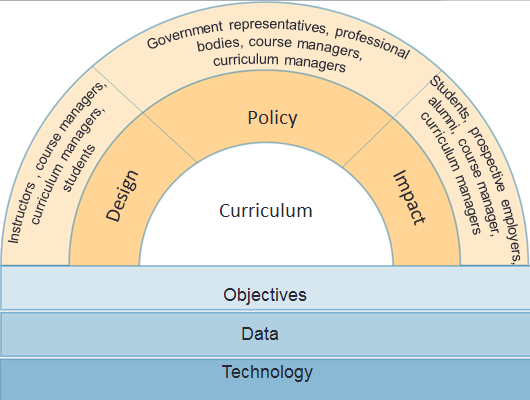Curriculum Analytics: Concepts, Techniques and Tools
Gain insights into the curriculum
Dr. Venky Shankararaman, Dr. Swapna Gottipati
Curriculum analysis unpacks the three education components namely the intended outcomes, content, and the learning activities with a purpose to evaluate how the individual components fit together in terms of consistency and alignment. It allows educators to analyse the strengths and weaknesses of the curricula in terms of all the three components. Furthermore, the analysis aims to justify the curriculum choices and assumptions, and it can be performed at the program level or at a specific course level.

In order to achieve these goals, several tasks are identified under the umbrella of curriculum analysis; assess alignment between program level outcomes and course level outcomes, determine whether the outcomes have been achieved, identify the gaps between the outcomes and assessments, analyse competencies acquisition, identify strengths which can be further built upon, study the impact on job opportunities, verify alignment with industry skills requirements, demonstrate the worth of the curriculum to different stakeholders, etc. Traditionally, curriculum analysis has been mostly a manual process which is tedious and painstaking work. However, the emergence of analytics techniques that leverages vast amounts of data sets to gain insights from the data which is both structured and unstructured has opened new possibilities for analysing the curriculum. The main objective of curriculum analytics is to use a data driven approach to gain insights into the effectiveness of the curriculum and thus improve the overall teaching and learning experience. This new capability, analytics technology, plays a major role to automate many stages and tasks of the curriculum analysis process.
The tutorial will introduce the concept of curriculum analysis and curriculum analytics, key components of a curriculum analytics framework, and application of curriculum analytics at the individual course or program level. The tutorial will also cover analytics techniques and tools relevant to curriculum analytics such as clustering, data visualization, and text analytics. Additionally, we will look at emerging and likely future trends in this field. The tutorial will include examples and exercises for participants' practice and discussion.
Key Learning Outcomes
On completing this tutorial, you will be able to
Explain the concept of curriculum analytics and the components of the curriculum analytics framework
Gain insights into how curriculum analytics can be applied to enhance teaching and learning
Understand where and how curriculum analytics can be applied in your school
Apply some of the techniques and tools to curriculum analytics
This tutorial is aligned with the objectives of the theme-based conference,
ICCE 2016 Sub-Conference on Advanced Learning Technologies (ALT), Learning Analytics and Digital Infrastructure.

